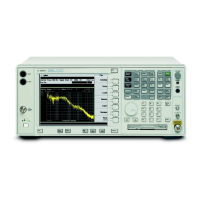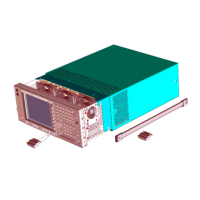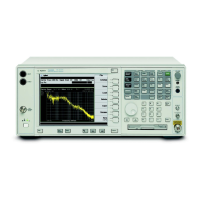120 Chapter 2
Front-Panel Key Reference
Marker
Marker
Accesses the marker control keys which select the type and number of
markers and turns them on and off. Markers are diamond-shaped
characters that identify points of traces. Up to four pairs of markers
may appear on the display simultaneously; only one pair can be
controlled at a time. The marker that is controlled is called the “active”
marker. Pressing
Marker activates the Normal menu key.
Select Marker
1 2 3 4
Selects one of the four possible markers. A marker that has already
been turned on will become active when it is selected. If a marker has
been turned on and assigned to a specific trace, it will become active on
that trace if that marker is selected.
Key Access:
Marker
Normal Activates a single frequency marker at the center position of the active
trace if a marker is not already displayed. If a marker is displayed
before the
Normal function is enabled, the marker is enabled at the
position of the selected marker. The marker number is indicated above
the marker. Use the data controls to position the marker. The knob
and/or Up/Down keys move the marker left or right. If a value is
entered from the numeric keypad, the marker is moved to the trace
point nearest to that value. Annotation in the active function block and
in the upper-right corner of the display indicates the frequency and
amplitude of the marker (time and amplitude, if in zero span.) The
marker stays on the trace at the horizontal screen position where it was
placed unless
Signal Track, or a “marker to” key function (such as Mkr
→
CF
, Mkr
→
RL, Mkr
→
CF STEP, Mkr
∆
Span, or Min Search) is
selected.Pressing
Normal turns off the Delta function and moves the
active marker to the delta marker position.
Key Access:
Marker
Delta Activates a second marker at the position of the first marker. (If no
marker is present, two markers appear at the center of the display.) The
amplitude and frequency (or time) of the first marker is fixed. The
marker number is indicated above the delta marker, and the same
number is indicated with an R (for example, 1R) above the reference
marker. Use the data controls to position the delta marker. Annotation
in the active function block and in the upper-right corner of the display
indicates the frequency (or time) and amplitude differences between the
two markers. The markers will be turned off if the scale type is changed
between log and linear. (For information on using this function while in
segmented sweep, refer to “Interaction with Other Analyzer Functions”
in the segmented sweep section of this chapter which begins on
“Segmented” on page 197.)
Key Access:
Marker
